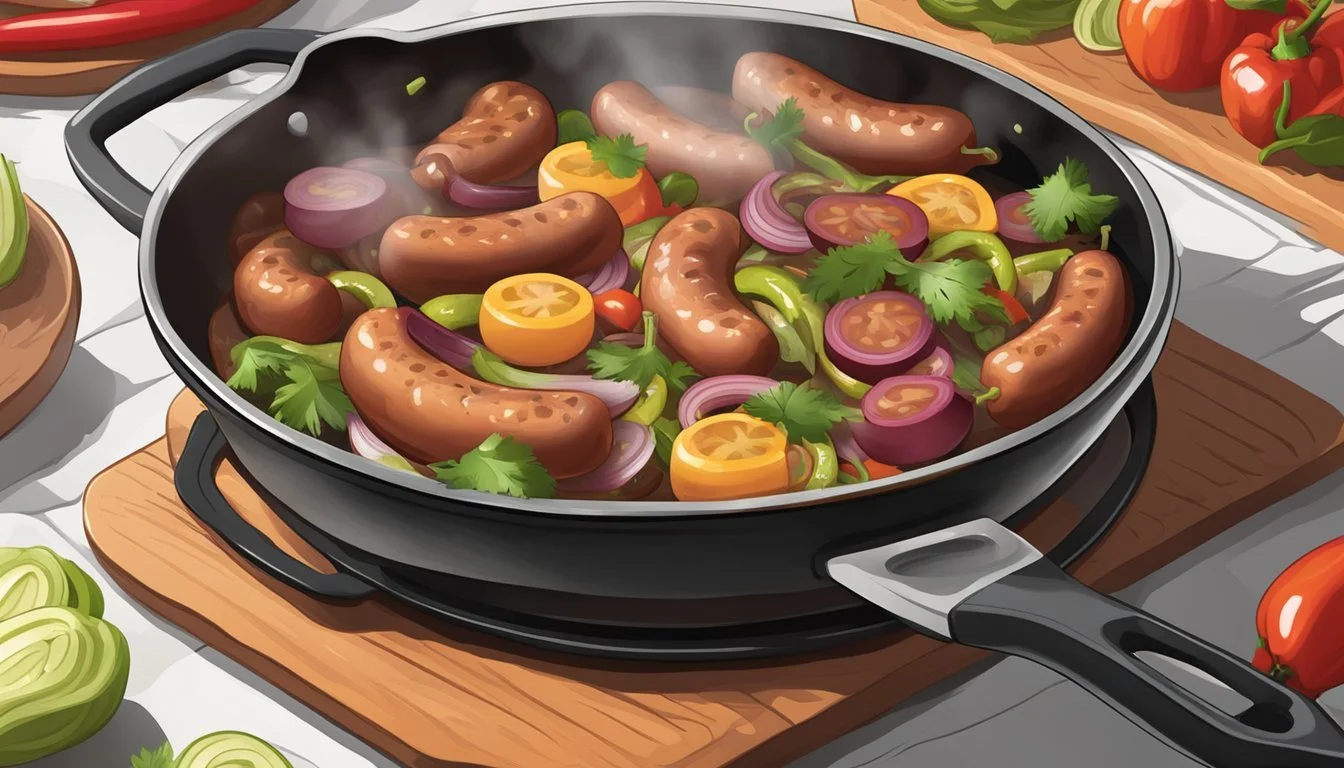Mastering Kielbasa
Delicious Ways to Cook this Polish Sausage
Kielbasa, a flavorful Polish sausage, offers versatility in the kitchen and can be prepared using various cooking methods. This smoked pork and beef sausage, seasoned with garlic and spices, brings a rich, savory taste to any meal. Kielbasa can be boiled, baked, grilled, fried, or air fried, each method imparting its own unique flavor and texture to the sausage.
Whether you're working with fresh or pre-cooked kielbasa, the cooking process is straightforward and yields delicious results. Boiling is a quick and easy method, while baking or grilling can enhance the smoky flavor and create a crispy exterior. For those seeking a healthier option, air frying provides a crispy texture without excess oil.
Kielbasa pairs well with traditional accompaniments like sauerkraut, mustard, and pierogies, but it also complements a variety of vegetables and side dishes. Its versatility makes it a popular choice for everything from casual weeknight dinners to festive gatherings. By mastering the art of cooking kielbasa, home chefs can unlock a world of culinary possibilities with this iconic Polish sausage.
Kielbasa 101
Kielbasa, a beloved Polish sausage, has a rich history and comes in various types. Selecting quality kielbasa is key to enjoying its full flavor and texture.
History of Kielbasa
Kielbasa originated in Poland over 500 years ago. The word "kielbasa" simply means "sausage" in Polish. Initially made from pork, it served as a way to preserve meat before refrigeration.
Kielbasa gained popularity throughout Eastern Europe and eventually spread worldwide. Polish immigrants brought their recipes to America in the early 20th century, introducing this savory sausage to a new audience.
Today, kielbasa remains a staple in Polish cuisine and is enjoyed globally. Its production has evolved, with modern techniques enhancing flavor and shelf life while maintaining traditional recipes.
Types of Kielbasa
Kielbasa comes in several varieties, each with distinct characteristics:
Smoked Kielbasa: The most common type, typically made from pork or a pork-beef blend.
Fresh Kielbasa: Uncooked and requires thorough cooking before consumption.
Turkey Kielbasa: A leaner alternative made with turkey meat.
Kabanosy: A thin, dry-cured sausage often eaten as a snack.
Regional variations exist, with different spice blends and meat ratios. Some kielbasa types are named after Polish cities, reflecting local traditions and ingredients.
Selecting Quality Kielbasa
Choosing high-quality kielbasa ensures the best flavor and texture. Look for sausages with a firm, even texture and no air pockets. The casing should be intact and free from blemishes.
For smoked kielbasa, a deep reddish-brown color indicates proper smoking. Fresh kielbasa should have a pinkish hue. Check the ingredient list for natural components without excessive additives.
Quality kielbasa has a balanced fat content, which contributes to its juiciness and flavor. Avoid sausages with excessive visible fat or a greasy exterior.
When possible, purchase from reputable butchers or specialty stores known for their Polish products. This often ensures authenticity and adherence to traditional recipes.
Preparing Your Ingredients
Properly preparing ingredients enhances the flavor and texture of kielbasa dishes. Selecting complementary vegetables and seasonings can elevate the meal.
Vegetable Pairings
Onions are a classic pairing with kielbasa. Slice yellow or white onions thinly and sauté them until golden brown. Bell peppers add color and sweetness - cut them into strips or chunks.
Potatoes make an excellent side dish. Cube them into 1-inch pieces for even cooking. For a healthier option, consider adding carrots, celery, or cabbage.
Sauerkraut is traditional and adds tang. Rinse it before using to reduce saltiness if desired.
Seasoning and Marination
Kielbasa is pre-seasoned, but additional spices can enhance its flavor. Garlic powder or minced fresh garlic complements the meat well.
For a Polish-inspired dish, add dried marjoram, black peppercorns, and a bay leaf. Paprika brings color and mild heat.
Salt sparingly, as kielbasa is often already salty. Fresh herbs like parsley or dill add brightness.
To marinate, mix oil with your chosen spices. Coat the kielbasa and refrigerate for 30 minutes to 2 hours before cooking.
Cooking Methods
Kielbasa can be prepared using various cooking techniques to bring out its rich flavors and achieve the desired texture. Each method offers unique benefits and results.
Grilling Kielbasa
Grilling imparts a smoky flavor and crispy exterior to kielbasa. Preheat the grill to medium heat. Place whole kielbasa links or 3-4 inch pieces on the grates. Grill for 4-5 minutes per side, rotating occasionally. Use tongs to prevent puncturing the casing. The internal temperature should reach 160°F (71°C). For added flavor, brush with a mixture of olive oil and herbs before grilling.
Grilled kielbasa pairs well with grilled vegetables or can be served in buns as a hearty sandwich. The charred exterior and juicy interior make for a delicious contrast in textures.
Baking Kielbasa
Baking offers a hands-off approach to cooking kielbasa. Preheat the oven to 350°F (175°C). Line a baking sheet with parchment paper or use a baking dish. Arrange kielbasa pieces in a single layer, leaving space between them for even cooking.
Bake for 25-30 minutes, turning once halfway through. The sausage should be golden brown and reach an internal temperature of 160°F (71°C). For added flavor, toss kielbasa with sliced onions, bell peppers, and a drizzle of olive oil before baking.
Boiling and Simmering
Boiling and simmering are gentle methods that help retain moisture in kielbasa. Fill a pot with water or beef broth and bring to a simmer. Add whole kielbasa links and cook for 15-20 minutes.
For extra flavor, add herbs, garlic, or bay leaves to the cooking liquid. Once cooked, remove the kielbasa and pat dry. This method is ideal for preparing kielbasa for recipes or before finishing with another cooking technique.
Stovetop Techniques
Pan-frying and sautéing are quick stovetop methods for cooking kielbasa. Slice kielbasa into 1/4-inch rounds. Heat a skillet over medium heat and add a small amount of cooking oil.
Cook the slices for 2-3 minutes per side until golden brown. For added flavor, sauté onions in the pan before adding the kielbasa. This method creates a crispy exterior while heating the sausage through.
Alternative Methods
Microwave cooking offers a quick option for reheating pre-cooked kielbasa. Place slices on a microwave-safe plate and cook on high for 30-45 seconds.
Air frying is another alternative that produces crispy results. Preheat the air fryer to 380°F (193°C). Arrange kielbasa pieces in the basket and cook for 8-10 minutes, shaking halfway through.
Always use a food thermometer to ensure the internal temperature reaches 160°F (71°C) for food safety, regardless of the cooking method chosen.
Serving and Presentation
Kielbasa's versatility shines through in its serving options and presentation styles. From casual appetizers to hearty main courses, this Polish sausage adapts to various culinary settings.
Accompaniments
Kielbasa pairs well with a range of side dishes. Sauerkraut offers a tangy contrast to the rich sausage flavor. Mustard, particularly whole-grain varieties, complements kielbasa's savory profile.
Mashed potatoes provide a creamy backdrop, while pierogies add a traditional Polish touch. For a lighter option, serve kielbasa with corn on the cob or a crisp salad.
Sandwiches are a popular way to enjoy kielbasa. Place sliced sausage in a bun with sautéed onions and peppers for a satisfying meal. Grilled bell peppers add sweetness and color to the plate.
Plating Techniques
For appetizers, slice kielbasa thinly and arrange on a platter with toothpicks for easy serving. Create an eye-catching display by fanning out the slices in a circular pattern.
When serving as a main course, consider these plating ideas:
Slice kielbasa diagonally and fan out on the plate
Arrange whole links in a curved shape around sides
Cut into bite-sized pieces and mix with sautéed vegetables
Garnish with fresh herbs like parsley or dill for added color. Use colorful serving dishes to enhance presentation. For a rustic look, serve kielbasa on wooden boards or in cast-iron skillets.
Nutritional Information
Kielbasa provides a significant source of calories and protein, but it's also high in fat. Understanding its nutritional profile is crucial for those monitoring their diet or with specific dietary needs.
Calories and Protein Content
A typical 2-ounce serving of kielbasa contains approximately 127 calories. The bulk of these calories come from fat, with protein being the second most abundant macronutrient. A 100-gram portion of kielbasa provides about 226 calories.
Protein content in kielbasa is substantial. A 2-ounce serving offers around 7 grams of protein, contributing to daily protein requirements. For a 100-gram serving, the protein content increases to about 12-15 grams.
Fat content is high in kielbasa, with a 2-ounce serving containing roughly 11 grams. Carbohydrate content is relatively low, typically less than 2 grams per serving.
Consideration for Dietary Restrictions
Kielbasa may not be suitable for all dietary needs. Its high fat and calorie content make it a concern for those watching their weight or managing heart health. Sodium levels in kielbasa are often high, which can be problematic for individuals on low-sodium diets.
Most kielbasa contains gluten-free ingredients, but cross-contamination during processing is possible. Those with celiac disease or gluten sensitivity should check labels carefully.
For individuals following kosher or halal diets, traditional pork-based kielbasa is not suitable. However, beef or turkey variants may be available that meet these dietary requirements.
Moderation is key when incorporating kielbasa into a balanced diet. Pairing it with vegetables or whole grains can help offset its high calorie and fat content.
Food Safety and Storage
Proper storage and handling of kielbasa are crucial for maintaining its quality and safety. Following recommended practices helps prevent foodborne illness and preserve flavor.
Proper Storage Practices
Store fresh kielbasa in the refrigerator at 40°F (4°C) or below for up to 2 days before cooking. Place it in a sealed container or wrapped tightly in plastic wrap to prevent cross-contamination. Cooked kielbasa can be refrigerated for 3-4 days.
For longer storage, freeze kielbasa at 0°F (-18°C) or below. Wrap it tightly in freezer paper or heavy-duty aluminum foil, or place it in a freezer bag. Frozen kielbasa maintains quality for 1-2 months.
Always label packages with the date of storage. Use the oldest items first to ensure freshness.
Reheating Leftovers
Reheat leftover kielbasa to an internal temperature of 165°F (74°C). Use a meat thermometer to verify the temperature. This ensures any bacteria that may have grown during storage are destroyed.
Microwave: Place kielbasa on a microwave-safe plate and heat in 30-second intervals, turning occasionally.
Stovetop: Slice kielbasa and pan-fry over medium heat until hot throughout.
Oven: Wrap kielbasa in foil and heat at 350°F (175°C) for 10-15 minutes.
Avoiding Foodborne Illness
Cook raw kielbasa thoroughly to kill harmful bacteria. The internal temperature should reach 160°F (71°C) for pork or beef kielbasa, and 165°F (74°C) for poultry kielbasa.
Wash hands, utensils, and surfaces before and after handling raw kielbasa. Use separate cutting boards for raw meats and other foods.
Do not leave kielbasa at room temperature for more than 2 hours. In hot weather (above 90°F/32°C), reduce this time to 1 hour.
Discard any kielbasa with an off odor, slimy texture, or signs of mold growth.
Recipes and Variations
Kielbasa's versatility shines through in both classic preparations and creative twists. From hearty dinners to quick snacks, this Polish sausage adapts to a variety of dishes.
Classic Kielbasa Recipes
Traditional Polish dinners often feature kielbasa as a star ingredient. A simple yet satisfying meal pairs grilled kielbasa with sauerkraut and boiled potatoes. For a heartier option, try kielbasa and beans. Slice the sausage, sauté it with onions, and mix with baked beans for a comforting dish.
Kielbasa also works well in soups. Add it to a pot of cabbage soup or use it in a classic Polish kapusniak. For a quick meal, fry kielbasa slices and serve with mustard or horseradish as a tasty snack.
Creative Twists on Traditional Flavors
Innovative cooks have found new ways to incorporate kielbasa into modern recipes. Kielbasa adds a smoky flavor to pasta dishes. Try it in a creamy mac and cheese or toss it with penne and roasted vegetables.
For a lighter option, add grilled kielbasa slices to salads. Pair it with mixed greens, cherry tomatoes, and a tangy vinaigrette. Kielbasa also works well in breakfast dishes. Dice it and add to a breakfast scramble or frittata.
Spice lovers can kick things up by serving kielbasa with hot sauce or creating a spicy kielbasa chili. These recipes often gain popularity on social media platforms like Instagram, Facebook, and Pinterest.
Conclusion
Kielbasa offers versatility and delicious flavor for many dishes. This Polish sausage can be prepared using various cooking methods to suit different tastes and meal preferences.
Grilling imparts a smoky char, while pan-frying creates a crispy exterior. Baking allows for easy preparation, and boiling results in a tender texture.
For a quick meal, slice and sauté kielbasa with vegetables. Add it to soups and stews for hearty flavor. Serve alongside pierogies or potatoes for a traditional Polish feast.
Experiment with different cooking techniques to find your favorite way to enjoy kielbasa. Its robust taste complements a wide range of ingredients and cuisines.
Remember to cook kielbasa thoroughly before serving. The internal temperature should reach 165°F (74°C) for food safety.
With these tips and methods, you can confidently incorporate kielbasa into your culinary repertoire. Its rich flavor and adaptability make it a welcome addition to many meals.





